Materials in nano-scale appeared as one of the phenomenal and unique materials to the modern world due to their excellent features such as high surface area, small size, high stability, high reactivity and versatile chemistry for the surface functionalisation. The physicochemical features of these materials in the range between 1 and 100 nm are completely different compared to the same materials at macroscale. These unique and great characteristics of intelligent nanomaterials make them excellent candidates for pharmaceutical analysis which basically determines the quality of pharmaceutical products through analytical chemistry. In this review paper, intelligent nanomaterials and their applications in pharmaceutical analysis is discussed. Innovative techniques for the application of intelligent nanomaterials in the analysis of pharmaceutical compounds in terms of various economic drawbacks, safety and health concerns of nanomaterials and life cycle assessment within pharma industry are also described. Finally, the drawbacks, challenges and new opportunities for the future design and development of intelligent nanomaterials for pharmaceutical analysis are discussed..
Nanotechnology has brought a revolution in the area of medicine and an exponential development was reported in the nanotechnology related-patents for the pharmaceutical applications in the past twenty years. The pharmaceutical companies are deeply focused on the nanotechnology to overcome the drawbacks and find out the solutions for the challenges in the production of pharmaceutical compounds and come up with safe, cheap and highly sensitive approaches and techniques for drug development. The tools in nanotechnology are adding great value to the existing commercial products thereby providing new opportunities in the various segments of R&D in pharmaceutical companies.
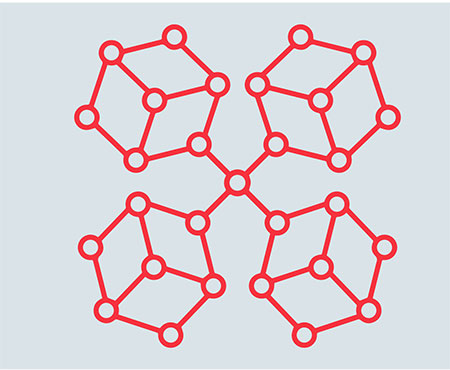
On the other side, process development refers to both design and synthesis of pharmaceutical compounds, their intermediates, and the development of the efficient analytical techniques for diagnostic applications. A miniaturised automation platform provides the design and development of efficient high-throughput synthetic routes for the drug discovery or synthesis processes. The studies for break-through pharmaceuticals require facile and fast synthesis of complex compounds and testing of their biological activities but the availability of short supply of substrate molecules is a limitation. This limitation can be overcome by applying the miniaturisation approach. In this approach, the idea is to do scale synthesis using high precision nanoliter robotics (i.e. hundreds of a reaction could be carried out in a single day using as little as 0.02 milligrams of material per reaction). The rapid and sensitive identification of synthesised pharmaceutical compounds is very crucial during the preclinical development process. In the preformulation stage, the availability of the compound is scarce and thus, development of formulation should be performed in the very low quantities of the target pharmaceutical compound. Therefore, nanosuspension formulations were found to be valuable at the screening step.
Nanotechnology addresses these issues by designing and applying of intelligent nanomaterial-based drug delivery systems which are capable of achieving enhanced biopharmaceutical features by altering the biopharmaceutical and pharmacokinetics features of the target pharmaceutical compound. Various nanomaterials such as polymeric nanoparticles, liposomes, nanoemulsions, micelles and dendrimers can be successfully used as nanodrug delivery systems (Figure1). With the innovative nanoscience and nanotechnologybased approaches, nanomaterials having different functionalities, shapes and distinct physical, chemical and biological features were designed and developed for the successful applications in the pharma industry.
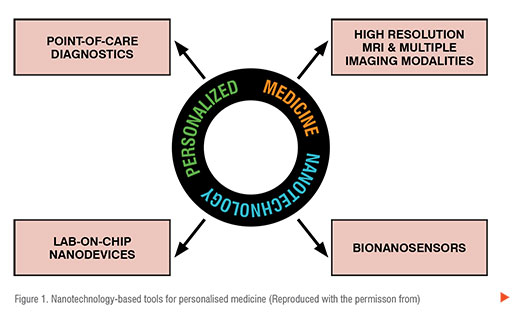
The intelligent nanomaterials exhibit biomimetic features since they can change their unique features that enables them to be applied in drug delivery and selfhealing materials. The examples include the application of intelligent polymeric nanomaterials as artificial muscles that can contract and return to original shape when short-circuited. These can replicate muscular action and can have strong visual effects.
One of latest interesting and promising research field is the designing and development of intelligent nanomaterials whose structure and chemical features are responsive to the biocatalytic action of natural enzymes. Enzymes play a crucial role in all metabolic and biological processes and their deregulation is a feature of many diseases. Therefore, the intelligent nanomaterials can efficiently sense these enzymes in the physiological environment and behave as an effective and promising tool for therapeutic and diagnostic applications. Various examples of enzyme responsive- intelligent nanomaterials are polymeric nanomaterials, phospholipids and inorganic nanomaterials. Functional Mesoporous Silica Nanoparticles (MSNs) were successfully designed and prepared by using alkoxysilane tether, a-cyclodextrin and multifunctional peptides to target tumor cells and decrease the side effects of Doxorubicin (DOX) which is an antitumor drug. The multifunctional peptides were composed of the cell-penetrating peptide of seven arginine (R7) sequence, an enzyme-cleavable peptide of GFLG and a tumor-targeting peptide of RGDS. When MSNs loaded with DOX are incubated with tumor cells and normal cells, the nanoparticles could efficiently target tumor cells through the specific interactions between RGDS and integrins receptor avß3 overexpressed on tumor cells, followed by penetrating cell membrane with the aid of R7 sequence. Once DOX-loaded silica nanoparticles penetrate into the cellular membrane, the antitumor drug DOX is quickly released because of the breakage of GFLG peptide cleaved by cathepsin B, resulting in increased antitumor activity. This effective enzyme-responsive nanoparticle based-drug delivery system exhibit an excellent potential in the area of nanomedicine (Figure 2).
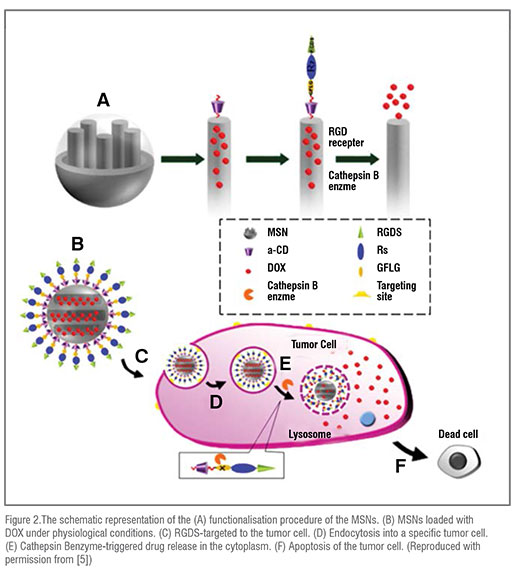
3.1. Applications of electrochemical sensors-based on intelligent nanomaterials
Electrochemical techniques have found many applications in various areas. This is because they are costeffective and are capable of carrying out in-situ and real-time studies. Over the past four decades, there has been increased demand in the area of electrochemical methods that have capability to detect low concentrations of the analytes. The analyte recognition is among the major processes involved in any sensor system. Additionally, the increased demand is as a result of their speed, portability, specificity and low cost. Selectivity and sensitivity are important paramaters for the electrochemical sensors. Surface modification of electrodes in electrochemical sensors by immobilisation of recognition components is an efficient approach to obtain a high binding of target compound with good selectivity and good response. The surface modification of electrodes in the design and preparation of electrochemical sensors has firstly been reported by Itaya and Bard in 1978. Since then, a lot of studies on the design and development of electrochemical sensors in different application areas have been published.
Graphene-based electrochemical sensors have received a great deal of attention due to their great ability for the sensitive detection of organic compounds. The high surface area renders enhanced the process of electron transfer enabling a highly attractive support for the incorporation of nanoparticles. In an interesting work carried out by Biris et al., gold nanoparticles were successfully embedded in the graphene sheets. The platinum electrode was then modified with the prepared graphene-based nanocomposite for the sensitive detection of adenine, one of the DNA bases. In their study, the authors concluded that the kinetics of the interfacial charge transfer on the platinum electrode surface modified with graphene lead to an increase in the electrochemical oxidation of the target compound adenine.
In another study, Zhang and colleagues reported the preparation of a graphene based-electrochemical sensor for the efficient detection of acetaminophen in pharmaceutical tablet samples. In their study, reduced graphene oxide was doped with phosphorus and then coated on the surface of glassy carbon electrode. The prepared electrochemical sensor displayed excellent sensitivity and selectivity towards acetaminophen in pharmaceutical tablet samples. The sensor response was linear in the concentration range from 1.5 µM to 120 µM. The detection limit was achieved as 0.36 µM.
3.2. Separation applications of intelligent nanomaterials
Gold nanoparticles were successfully applied in the Capillary Electrophoresis (CE)-based analysis due to the improved separation resolutions. These nanoparticles also behave as a pseudo-stationary phase in the existence of poly (ethylene oxide) (PEO) for the efficient separation of double-stranded DNA. The interaction between PEO and DNA molecule is increased in the existence of nanoparticles thereby enhancing the sieving ability of PEO without any change in its viscosity. The separation of acidic and basic proteins using a capillary filled with surfactant capped gold nanoparticles were also reported along with great separation efficiencies towards various target compounds. A facile approach was developed and demonstrated for the fabrication of highly effective separation columns coated with octadecylaminecapped gold nanoparticles for open tubular capillary GC.
Monodispersed silica nanotubes having desired size and shape were designed and successfully prepared by using template-assisted synthesis approach. These developed nanotubes have inner voids which can be filled with various compounds varying from large protein molecules to small molecules and the inner and outer surfaces of the nanotube can be efficiently functionalised. One of the interesting applications of the nanotubes is the intelligent nanophase extractor for the efficient removal of small compounds from the solution. Because the outer surface of the nanotubes exhibits hydrophilic feature and inner surface shows hydrophobic behaviour, these nanomaterials are promising candidates for the efficient extraction of the lipophilic compounds from the aqueous samples. The nanotube functionalised with antibody enables an ultimate extraction selectivity. The antibody produced against the drug, 4-[3-(4-fluorophenyl)-2-hydroxy-1-[1,2,4]-triazol-1-yl-propyl]-benzonitrile(FTB) selectively binds to the RS enantiomer and the Fab fragments of the antibody are immobilised on the inner and outer surfaces of the silica nanotubes.
3.3. Clinical applications of intelligent nanomaterials
Among various applications of intelligent nanomaterials, the most promising applications are in the area of biomedical sciences. These interesting applications have crucial effects on the human health since these nanomaterials are targeted towards the diagnostic techniques for disease which are fast and low-cost. To decrease the side effects and increase the therapeutic effects, the pharmaceutical compounds should be selectively targeted at the disease site and accumulate for a prolonged time in the body. Drug release refers to the design and development of efficient approaches, techniques and formulations required to transport any pharmaceutical compound safely within the body in order to obtain the efficient therapeutic effects. In this regard, intelligent nanomaterial based-drug release systems have opened new opportunities in the area of medicine. Intelligent nanomaterial based-drug release systems accumulate and binds specifically to the disease target with controlled release behaviour. The careful design and preparation of these nanomaterials as effective drug carriers should address various key issues such as biodegradability and biocompatibility, high stability at physiological pH values, excellent drug loading capacity without any toxicity and industrial production of these nanomaterials in large-scale for clinical applications. The stimuli responsive intelligent drug release systems deliver the drug at specific tissues in the systematic administration. These do not freely extravasate during the blood circulation and are released at the targets where the nanocarriers accumulate by active or passive targeting strategy.
An immunoassay is a biochemical technique which is efficiently applied for detection concentrations of a small macromolecule in a sample solution by using an antigen or an antibody. In this approach, the key issue is to obtain a measurable signal in response to a binding effect. Screen-printed electrodes have attracted great attention as immunosensors because of their unique features such as miniaturised dimension, low cost and facile fabrication and large-scale production. A single drop of sample i.e only a few microliters of a sample solution is used to conduct all the immunological stages thereby decreasing the consumption of the reagents. Screen-printed electrodes can be successfully coated with nanoparticles that increase the sensitivity of these electrodes. In an interesting study, a screen-printed electrode was modified with silver nanoparticles and effectively applied for the preliminary screening of cystic fibrosis that is a common genetic disease caused by the autosomal recessive gene known as the cystic fibrosis transmembrane conductance regulator gene. It affects multiple organs such as lungs and intestines which causes the irregular transport of chloride and sodium ions across the epithelial cells. It has been reported that the oxidation of silver is sensitive to concentration of chloride ions. Sweat chloride levels are important for the effective diagnosis of cystic fibrosis. A layer of silver nanoparticles is deposited on the working electrode and anodically stripped off to generate silver cations. The anodic stripping voltammetry of silver nanoparticles yields a single silver oxidation peak in the absence of chloride ions whereas two voltammetry stripping peaks (one for AgCl and other for the oxidation of Ag to Ag(I) ions) are obtained observed in the existence of chloride ions. The silver chloride peak is used for the quantitative determination of chloride concentration.
On the other hand, Parkinson’s disease and Alzheimer’s disease are the most common neurodegenerative diseases which affected 1.6 per cent of the world population, and around twentysix million people, respectively. This has posed a growing challenge for the patients, clinicians, caregivers and society. The current treatment approaches rely on the clinical symptoms of the diseases and therefore the efficient diagnostic techniques depend on the proficiency of the treating physician. Nanoparticle-basedsensor systems are successfully applied to distinguish groups of Parkinson’s and Alzheimer’s disease patients from a healthy control group. The diagnostic approach relies on the identification of patterns of volatile organic compounds in the exhaled breath. The disease-related changes in the blood chemistry may be transmitted to the alveolar exhaled breath through the lungs even in the initial stages of the disease. The nanoparticle-based sensor undergoes fast and reversible changes in electrical resistance on being exposed to characteristic volatile organic compounds. Thus, breath prints can be the basis for the design and fabrication of facile, low-cost, non-invasive biomarker using nanoparticle-based sensor systems.
3.4. Spectroscopic applications of intelligent nanomaterials
Silver nanoparticles show great Surface Plasmon Resonance (SPR) behaviour and thus, they are capable of ultra-sensitive analysis down to single molecule level in surface enhanced Raman scattering (SERS). However, various crucial parameters should be considered when silver nanoparticles are used. These factors are the analytes/probes in direct contact with the surface of silver nanoparticles can lead to an interference in the spectroscopic analysis, the mechanism of SPR mediated chemical reactions is complex because the dual functions of silver nanoparticles, silver is easily oxidised under ambient conditions that leads to reduce in plasmonic enhancement. The silver nanoparticles can efficiently be integrated with graphene to increase their plasmonic performance. Shell isolated silver were reported to display excellent plasmonic features with high stability even after 16 months of storage. The silver nanoparticles also have the advantage of achieving Raman signals with great quality and can be further expanded to surface-enhanced fluorescence that is efficiently used for the sensing and biological imaging applications.
3.5. Pharmaceutical applications of intelligent nanomaterials
Hydrogel-forming polysaccharides attracted great interest in the design and preparation of silver nanoparticles having different sizes and morphologies. Polysaccharide-based hydrogels are effective and intelligent materials that are extensively applied in pharmaceuticals, cosmetics and daily life. Hydrogels were successfully employed as templating or capping agents for the preparation of silver nanoparticles. One of the potential hydrogel forming polysaccharide is glucuronoxylan. It has been efficiently used as a carrier for the targeted release of various pharmaceutical compounds because of its pH responsive on-off switching feature. The synthesis of Silver nanoparticles was carried out by using glucuronoxylan at alleviated temperature via diffuse sunlight assisted green technique. Intelligent nanomaterials composed of glucuronoxylan and silver nanoparticles are also successfully used in wound healing dressings. The hydrogel layer does not allow the bandage to fix in the wound area because of the moisture. Thus, patient compliance can be achieved by developing such types of bandages. The mechanism of wounds is based on the collagen content and tensile strength of epithelium tissues. The fast wound healing tendency is because of the cross-linking of the collagen fibers.
On the other hand, diabetes is one of the major health problem in the world that shows an alarming increase. Approximately 25 per cent of patients are at elevated risk of developing foot complications which is also called ‘diabetic foot ulcer’. In patients with diabetic foot ulcer, the process of wound healing is impaired. Various methods have been applied for the treatment of diabetic foot ulcer. But, these methods have some limitations. With the fast progress in the area of nanomedicine, nanoparticles exhibited remarkable results in wound healing processes. The achieved results indicated that diabetic foot ulcer displayed a good response when Fe2O3 nanoparticles are used. (Table 1)
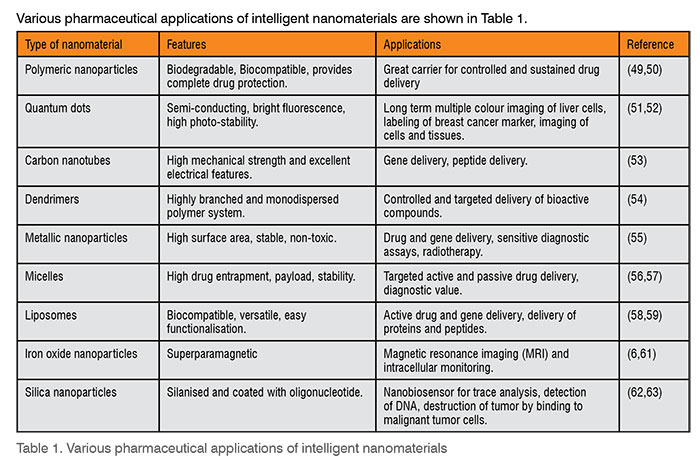
In summary, intelligent nanomaterials can be successfully used in many pharmaceutical applications. These applications are dependent on the surface modifications of the nanomaterial, their size and interactions with different target compounds.
Nanomaterials are extensively used in various industrial fields and among these fields, pharmaceutical industry is an emerging at a very fast pace. The global nanomedicine market is driven by emerging innovative approaches and techniques for drug release, different healthcare applications, and low-cost therapies. The nanomedicine area has revolutionised the current diagnostic techniques for diseases. The global nanomedicine market is categorised into diagnostic imaging, drug release, vaccines, regenerative medicine and implants etc. The global nanomedicine market accounted for US$111,912 million in 2016, and is expected to reach US 261,063 million by 2023.
With the rapid progress in nanotechnology and nanoscience, National Institute of Health (NIH) promoted a National Nanotechnology Initiative (NNI) programme in 2000 to promote the nanoscience-based studies in health science. Extensive funding from the government stimulated the launch of interdisciplinary studies. With novel approaches in nanomedicine, the area of nanoscience was rapidly adapted by researchers in pharma industry to create ‘nanopharmaceuticals’. In 2016, the size of the nanomedicine market in the world was estimated to be US$138.8 billion. The existence of 40 per cent pharmaceutical products in phase II of clinical development is anticipated to be commercialised over the next decade (https://www.grandviewresearch.com/industry-analysis/nanomedicine-market).
4.1. Economical drawbacks
Nanomedicine has a crucial role in efficient diagnosis and treatment of diseases across the entire healthcare spectrum. However, size of the market, economic value, and fields of application remain unclear. The European Scientific Foundation (ESF) identified 5 main fields of nanomedicine including analytical tools, nanoimaging, nanomaterials and nanodevices, novel therapeutic and drug release systems, clinical, regulatory and toxicological issues. According to the authorities, there are no scientific hurdles which can block the entry of nanomedicine products in the market since most of the techniques and approaches are now in the mature state. However, there seem to be external parameters (i.e. availability of capital, technology transfer management universities, intellectual property landscape and regulatory issues etc.) which hinder the commercialisation of nanomedicine.
For it to succeed, the cooperation of main pharmaceutical and medical device companies is needed since these have the means to finance clinical trials of diagnostic devices and new pharmaceutical compounds. Though researchers claim that the technologies are fruitful for the commercialisation but representatives from the pharmaceutical companies caution that the technologies are not mature enough so that investments can be provided. Therefore, this lead to very slow uptake of any biotechnology by the pharmaceutical companies. Therefore, these companies wait for the cutting-edge technology which has the potential to move ahead with financial investment.
4.2. Safety and health issues of nanomaterials
With the rapid advancements in nanotechnology, the design and production of engineered nanomaterials dramatically increases as well as incidental nanomaterials. Despite the excellent properties and many great applications of the nanomaterials, there are still some questions, challenges, drawbacks, and concerns about the potential influences of the nanomaterials on the natural environment and human health. The toxicity of the nanomaterials is one of the crucial concerns. Most of the nanomaterials will end up in the environment (air, water and soil). Because many of nanomaterials are not biodegradable, they may remain in the environment for a long time. Biological organisms such as micro-organisms, plants and animals could take up nanomaterials in the ecosystems and bring nanomaterials into the food chain. For example, nanoparticles can easily enter human body via respiratory system. Once nanoparticles enter the bloodstream after passing through the respiratory system, they can accumulate in the certain regions of the different organs. Therefore, the negative impacts due to the nanomaterials on human health should be carefully evaluated. For this purpose, a new field called “nanoecotoxicology” is gaining public attention. Furthermore, future applications of engineered nanomaterials are highly promising. Therefore, efforts and evaluations for the safety of nanomaterials on the environment and animal health will continue to be a research priority. Consequently, sophisticated statistical understanding and methodologies is carefully needed in the designing of toxicity studies and in analysing toxicity data. Prior to the use of nanomaterials especially for in vivo biological applications, various important physiological factors (i.e. distribution, absorption and toxicity) of these nanomaterials should be considered and carefully evaluated according to the international regulatory guidelines which are still under development.
Pharma companies are increasingly imparting a lot of importance on becoming more sustainable by developing pharmaceutical compounds which have same medicinal value but show less negative effect on the environment. The design, development and applications surrounding the pharmaceuticals play a crucial role in minimising their negative effects on the environment and increasing the sustainability of the healthcare. The progresses in the various areas of medicine including personalised medicine, drug design, targeted drug delivery, medical genetics, formulations and worldwide initiatives such as medications management and pharmaceutical care are bringing sustainability in quality health care close to reality. The schematic depiction of the interconnected view of sustainable development is shown in Figure 3. As can be seen from the figure, the sustainable development is divided into 3 categories including pharmaceuticals, environment, and health care. These categories are interconnected with each other and thus this model view of the sustainable development has a conceptual simplicity in terms of sustainable analysis of pharmaceutical compounds. The categorisation of the effetcs on human society based on these three categories makes the analysis facile and straightforward. When pharmaceuticals, environment and health care are balanced, they provide the sustainable development of the human society.
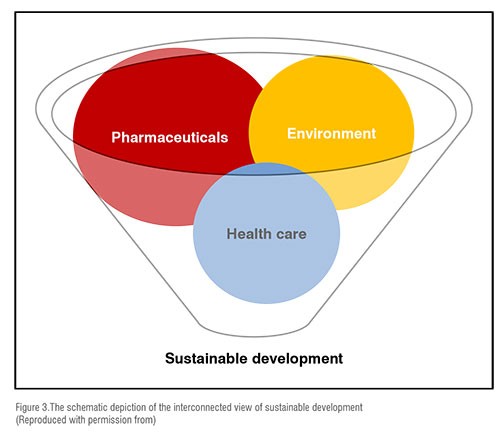
With the fast research advancements in the field of intelligent nanomaterials and nanobiotechnology, the current pharma industry mainly focuses on the inventing medicines, specially nanomedicines to allow patients to live longer, healthier and more productive lives. The pharma industry is committed to bring key nanomedicines to patients with minimum environmental effects. In the past years, the pharma companies paid great attention towards the improvement of productivity and quality, reduction in waste and control on both production process and R&D researches. These are not only driven by considerations in decreasing of production costs but also enhancing awareness of sustainability.
Intelligent nanomaterials have gained great attention from many researchers since they display unique properties such as high physical and chemical stability, versatile chemistry for the functionalisation and high surface area. The chemical features of intelligent nanomaterials in the scale between 1 and 100 nm are completely different compared to the materials in micro- and macroscale. At present, the opportunity of intelligent nanomaterials in pharmaceutical applications at industrial scale seems to be still growing at lower levels of its ability. In addition, it is expected that the use of intelligent nanomaterials in the pharmaceutical industry will play a crucial role in next-generation pharmaceutical technologies and devices in the near future.
The main objective of the modern research is to close the gap between the scientific laboratory research and practical applications in industry. Most of the research on the design and development of novel intelligent nanomaterials in the pharmaceutical analysis is carried is limited to lab scale in literature. Therefore, the studies on development of intelligent nanomaterials on a commercial scale are strongly recommended. In conclusion, commercialisation of nanotechnology-based innovative products is very important and needs enough investments from pharmaceutical and medical device corporations. In addition, optimistic approaches and methodologies are needed to motivate policy makers to design the applications of intelligent nanomaterials in sustainable systems. Many successful pharmaceutical applications of intelligent nanomaterials were reported in the literature. However, novel techniques and technologies applied for the production of intelligent nanomaterial-based products in pharmaceutical industry are still under development and more efforts are needed to produce lowcost and effective products before these intelligent nanomaterial-based pharmaceutical products are commercially available in the market.
--Issue 39--